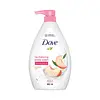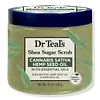What's inside
What's inside
 Key Ingredients
Key Ingredients

 Benefits
Benefits

 Concerns
Concerns

 Ingredients Side-by-side
Ingredients Side-by-side

Water
Skin ConditioningCocamidopropyl Betaine
CleansingSodium Methyl Lauroyl Taurate
CleansingSodium Lauroyl Isethionate
CleansingParfum
MaskingGlycerin
HumectantGlycol Distearate
EmollientPhenoxyethanol
PreservativeSodium Hydroxide
BufferingSodium Chloride
MaskingLauric Acid
CleansingLaureth-4
EmulsifyingSodium Isethionate
CleansingCaprylic Acid
CleansingCapric Acid
CleansingZinc Oxide
Cosmetic ColorantSodium Methyltaurate
Skin ConditioningPalmitic Acid
EmollientStearic Acid
CleansingTetrasodium EDTA
Iodopropynyl Butylcarbamate
PreservativePPG-9
Skin ConditioningPEG-150 Pentaerythrityl Tetrastearate
EmulsifyingLactic Acid
BufferingCitric Acid
BufferingSodium Ascorbyl Phosphate
AntioxidantPrunus Persica Juice
MoisturisingPropylene Glycol
HumectantGeraniol
PerfumingLimonene
PerfumingLinalool
PerfumingCI 19140
Cosmetic ColorantCI 17200
Cosmetic ColorantWater, Cocamidopropyl Betaine, Sodium Methyl Lauroyl Taurate, Sodium Lauroyl Isethionate, Parfum, Glycerin, Glycol Distearate, Phenoxyethanol, Sodium Hydroxide, Sodium Chloride, Lauric Acid, Laureth-4, Sodium Isethionate, Caprylic Acid, Capric Acid, Zinc Oxide, Sodium Methyltaurate, Palmitic Acid, Stearic Acid, Tetrasodium EDTA, Iodopropynyl Butylcarbamate, PPG-9, PEG-150 Pentaerythrityl Tetrastearate, Lactic Acid, Citric Acid, Sodium Ascorbyl Phosphate, Prunus Persica Juice, Propylene Glycol, Geraniol, Limonene, Linalool, CI 19140, CI 17200
Sucrose
HumectantGlycerin
HumectantSorbitol
HumectantWater
Skin ConditioningPolysorbate 20
EmulsifyingSilica
AbrasiveParfum
MaskingCitrus Aurantium Bergamia Fruit Oil
MaskingJuniperus Mexicana Oil
MaskingCitrus Aurantium Dulcis Peel Oil
MaskingButyrospermum Parkii Butter
Skin ConditioningCannabis Sativa Seed Oil
EmollientPersea Gratissima Oil
Skin ConditioningCitrus Sinensis Peel Oil Expressed
PerfumingOenothera Biennis Oil
EmollientMacadamia Ternifolia Seed Oil
EmollientPrunus Amygdalus Dulcis Oil
Skin ConditioningCarthamus Tinctorius Seed Oil
MaskingCocos Nucifera Oil
MaskingRetinyl Palmitate
Skin ConditioningAscorbic Acid
AntioxidantSorbic Acid
PreservativePhenoxyethanol
PreservativeEthylhexylglycerin
Skin ConditioningCI 19140
Cosmetic ColorantCI 42090
Cosmetic ColorantCI 17200
Cosmetic ColorantSucrose, Glycerin, Sorbitol, Water, Polysorbate 20, Silica, Parfum, Citrus Aurantium Bergamia Fruit Oil, Juniperus Mexicana Oil, Citrus Aurantium Dulcis Peel Oil, Butyrospermum Parkii Butter, Cannabis Sativa Seed Oil, Persea Gratissima Oil, Citrus Sinensis Peel Oil Expressed, Oenothera Biennis Oil, Macadamia Ternifolia Seed Oil, Prunus Amygdalus Dulcis Oil, Carthamus Tinctorius Seed Oil, Cocos Nucifera Oil, Retinyl Palmitate, Ascorbic Acid, Sorbic Acid, Phenoxyethanol, Ethylhexylglycerin, CI 19140, CI 42090, CI 17200
Ingredients Explained
These ingredients are found in both products.
Ingredients higher up in an ingredient list are typically present in a larger amount.
Ci 17200 is a synthetic reddish-purple dye.
CI 19140 is also known as Tartrazine. Tartrazine is a synthetic dye used in cosmetics, foods, and medicine to add a yellow color.
Tartrazine is created from petroleum and is water-soluble.
Some people may experience allergies from this dye, especially asthmatics and those with an aspirin intolerance.
Learn more about CI 19140Glycerin is already naturally found in your skin. It helps moisturize and protect your skin.
A study from 2016 found glycerin to be more effective as a humectant than AHAs and hyaluronic acid.
As a humectant, it helps the skin stay hydrated by pulling moisture to your skin. The low molecular weight of glycerin allows it to pull moisture into the deeper layers of your skin.
Hydrated skin improves your skin barrier; Your skin barrier helps protect against irritants and bacteria.
Glycerin has also been found to have antimicrobial and antiviral properties. Due to these properties, glycerin is often used in wound and burn treatments.
In cosmetics, glycerin is usually derived from plants such as soybean or palm. However, it can also be sourced from animals, such as tallow or animal fat.
This ingredient is organic, colorless, odorless, and non-toxic.
Glycerin is the name for this ingredient in American English. British English uses Glycerol/Glycerine.
Learn more about GlycerinParfum is a catch-all term for an ingredient or more that is used to give a scent to products.
Also called "fragrance", this ingredient can be a blend of hundreds of chemicals or plant oils. This means every product with "fragrance" or "parfum" in the ingredients list is a different mixture.
For instance, Habanolide is a proprietary trade name for a specific aroma chemical. When used as a fragrance ingredient in cosmetics, most aroma chemicals fall under the broad labeling category of “FRAGRANCE” or “PARFUM” according to EU and US regulations.
The term 'parfum' or 'fragrance' is not regulated in many countries. In many cases, it is up to the brand to define this term.
For instance, many brands choose to label themselves as "fragrance-free" because they are not using synthetic fragrances. However, their products may still contain ingredients such as essential oils that are considered a fragrance by INCI standards.
One example is Calendula flower extract. Calendula is an essential oil that still imparts a scent or 'fragrance'.
Depending on the blend, the ingredients in the mixture can cause allergies and sensitivities on the skin. Some ingredients that are known EU allergens include linalool and citronellol.
Parfum can also be used to mask or cover an unpleasant scent.
The bottom line is: not all fragrances/parfum/ingredients are created equally. If you are worried about fragrances, we recommend taking a closer look at an ingredient. And of course, we always recommend speaking with a professional.
Learn more about ParfumPhenoxyethanol is a preservative that has germicide, antimicrobial, and aromatic properties. Studies show that phenoxyethanol can prevent microbial growth. By itself, it has a scent that is similar to that of a rose.
It's often used in formulations along with Caprylyl Glycol to preserve the shelf life of products.
Water. It's the most common cosmetic ingredient of all. You'll usually see it at the top of ingredient lists, meaning that it makes up the largest part of the product.
So why is it so popular? Water most often acts as a solvent - this means that it helps dissolve other ingredients into the formulation.
You'll also recognize water as that liquid we all need to stay alive. If you see this, drink a glass of water. Stay hydrated!
Learn more about Water